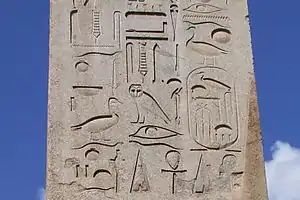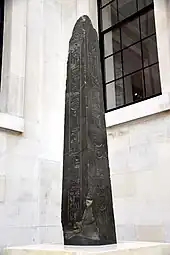Obelisk (hieroglyph)
The ancient Egyptian Obelisk hieroglyph, Gardiner sign listed no. O25 is a portrayal of the obelisk. The hieroglyph is commonly used on erected Egyptian obelisks, as there is often a discussion of the event of its erection: a historical event, as well as an accomplishment of the pharaoh, and the Egyptian Kingdom.

Middle column with story of the obelisk's erection (using mast and obelisk hieroglyph).
| Obelisk in hieroglyphs | ||
|---|---|---|
Usage
The obelisk hieroglyph in the Egyptian language is t(kh)n, and is the identical word with the same spelling (different determinatives), for 'to beat a drum', musician, etc. There are other meanings for 'tekhen', as well. The obelisk is a determinative in the Egyptian language, and the word t(kh)n has multiple spellings, since obelisk construction was done over various time periods. Some spellings are:[1]
The second spelling uses the shortened variety of the block-of-stone (hieroglyph),
as the 2nd determinative.
See also
Wikimedia Commons has media related to Obelisk (hieroglyph).
References
- Budge, 1978, (1920), An Egyptian Hieroglyphic Dictionary, section t,
p. 843b.
- Budge, 1978, (1920). An Egyptian Hieroglyphic Dictionary, E.A.Wallace Budge, (Dover Publications), c 1978, (c 1920), Dover edition, 1978. (In two volumes, 1314 pp, and cliv-(154) pp.) (softcover, ISBN 0-486-23615-3)
This article is issued from Wikipedia. The text is licensed under Creative Commons - Attribution - Sharealike. Additional terms may apply for the media files.

